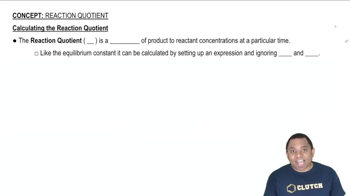Textbook Question
A mixture of 0.2000 mol of CO2, 0.1000 mol of H2, and 0.1600 mol of H2O is placed in a 2.000-L vessel. The following equilibrium is established at 500 K: CO2(g) + H2(g) ⇌ CO(g) + H2O(g) (d) Calculate Kc for the reaction.
1
views
 Verified step by step guidance
Verified step by step guidance



A mixture of 0.2000 mol of CO2, 0.1000 mol of H2, and 0.1600 mol of H2O is placed in a 2.000-L vessel. The following equilibrium is established at 500 K: CO2(g) + H2(g) ⇌ CO(g) + H2O(g) (d) Calculate Kc for the reaction.
(b) What condition must be satisfied so that Qc = Kc?
(a) If Qc > Kc, how must the reaction proceed to reach equilibrium?
(b) At the start of a certain reaction, only reactants are present; no products have been formed. What is the value of Qc at this point in the reaction?